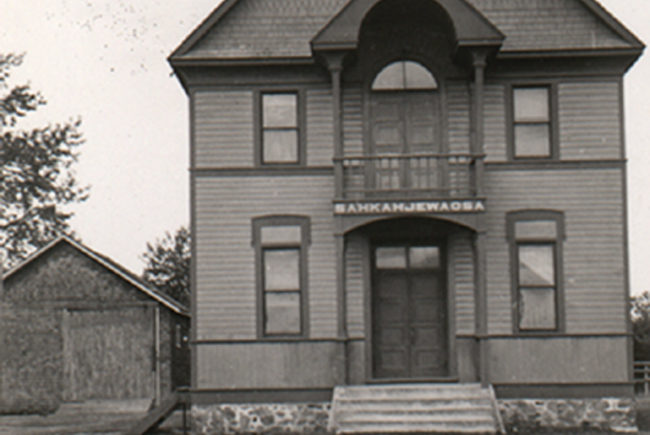Indian agents and fiddlers featured at Garden River hall

By Karl Hele
GARDEN RIVER FN — Sahkehjewaosa, a community hall named after one of Chief Shingwaukonse’s names, bound the community together, much like the old chief, through its presence and openness.
Here chief and council met, both the pre-Indian Act elected government and its elected predecessor, to discuss issues affecting the community as well as dealings with the Indian Agent, Canadian government, and notable settlers. Important pan-Indigenous meetings took place here, such as the Grand Council of Indian Tribes of Canada meeting in 1928 and the Native Council of Canada in 1963.
The hall, however, did not simply serve as a place for politics; it was after all a community hall. Irrespective of religious affiliation, the entire community often gathered at the hall to celebrate weddings, with many dances continuing well beyond the dawn. Dancers were treated to music performed by Garden River musicians playing big band, fiddle, jazz, swing, and country music. It also served as a place to welcome settlers and a venue for their productions of “Indian” culture as these newcomers raised funds to aid community ventures. For instance in May 1931 Mrs. Sam Jones, Mrs. A. Bussineau, Mrs. S. Wabonosa, Miss C. McPhail (teacher), Mrs. G. H. Sims (Indian Agent’s wife), Mrs. Thos. Thibault, and Mr. T. Larose organized an Indian Concert to raise prize money for the agricultural fair.
From the early 1900s to the 1950s the old hall served as a centre for Garden River’s fall fairs. The ground floor was a display area for many items such as mats and ash baskets, as well as fruits and vegetables. The second floor or upstairs served as a type of heritage centre or museum where cultural items and historical artifacts were displayed side by side. According to a Sault Star reporter in 1923, the display included “Chief Shingwauk’s ancient wooden peace pipe, some six feet in length with a stone bowl. The stem was curiously twisted. Then there was an old tomahawk with pipe, belonging to John Wigwaus, bows and arrows, hand made paddles, headdress of feathers, Indian suits of buckskin, bead work, and baskets”. Stationed around the hall was an “Indian village: as well as booths, coops, and stalls displaying other goods manufactured, baked, or raised by the community.
Like all buildings the hall needed regular maintenance and upgrading. The most extensive renovations took place in 1974-5 when it was insulated, wired, and plumbed for a kitchen and bathrooms. Community pride in its old hall was evident in the fact that people contributed their time and construction materials in an effort to stretch the limited government funding aimed at upgrading only the main floor. The Local Improvement Program and Indian Affairs granted just over $24,000 for repairs. When completed the interior walls were to be painted with a mural by Alex Half, an Anishinaabe painter from Kenora, thus giving the ground floor “a truly Indian” design. The upper floor would house a culture and resource centre as well as a library that would hold, according to Sault Star reporter H.A. Tynkaluk, “historical artifacts and data … to illustrate and perpetuate the heritage that is so dear to the hearts of the people” where “unity and identity” could be maintained.
The hall continued to be a popular venue for the community into the 1980s when it once again needed to be extensively upgraded. Unfortunately, before it could be remodeled the hall caught fire and burned to the ground. Even while the ashes were still smouldering Chief Denis Jones called for a new hall to be constructed. A new hall, Shke-Sahkehjewaosa, commonly known as the “big log house” was subsequently completed in 1991. While the new building is named after the old, it is within the central stained glass window that the past and present come together within the circle. The central element of the circular white, black, red, and yellow window is the sun rising over a teepee, which represents the community while at the same time reminding everyone of the chief, the old hall, and our resilience as a community. Today a band office, community centre, education centre, day care, and other band buildings serve the multiple functions of the old hall, which remains as a testimony to the importance and centrality of the old hall – it was simply a bigger place!


